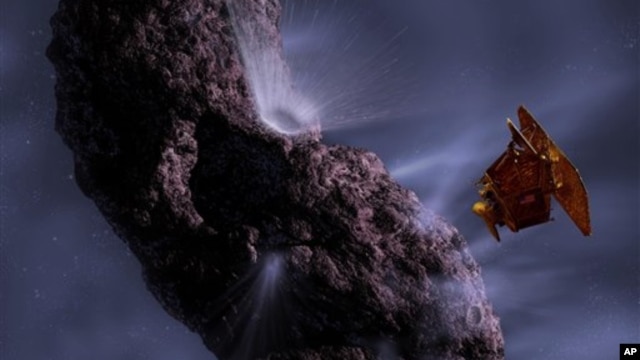- Sep 14, 2004
- 2,677
- 481
- 98
If you do not have Quicktime on your PC, you can get it here: http://www.apple.com/quicktime/download/win.html
Quicktime movie of impact on comet Tempel 1, as seen from the impactors companion spacecraft: http://www.nasa.gov/mov/121520main_HRI-Movie.mov
Quicktime movie of impact on comet Tempel 1, as seen from the impactor: http://www.nasa.gov/mov/121530main_its_approach_x4.mov
More Tempel 1 images:

This image shows the initial ejecta that resulted when NASA's Deep Impact probe collided with comet Tempel 1 at 10:52 p.m. Pacific time, July 3 (1:52 a.m. Eastern time, July 4) . It was taken by the spacecraft's medium-resolution camera 16 seconds after impact.

This image shows the view from Deep Impact's probe five minutes before it was pummeled by comet Tempel 1. The image was taken by the probe's impactor targeting sensor.

This image shows the view from Deep Impact's probe 90 seconds before it was pummeled by comet Tempel 1. The image was taken by the probe's impactor targeting sensor.

This image from NASA TV shows Deep Impact mission team members celebrating a successful encounter with comet Tempel 1.
Quicktime movie of impact on comet Tempel 1, as seen from the impactors companion spacecraft: http://www.nasa.gov/mov/121520main_HRI-Movie.mov
Quicktime movie of impact on comet Tempel 1, as seen from the impactor: http://www.nasa.gov/mov/121530main_its_approach_x4.mov
More Tempel 1 images:

This image shows the initial ejecta that resulted when NASA's Deep Impact probe collided with comet Tempel 1 at 10:52 p.m. Pacific time, July 3 (1:52 a.m. Eastern time, July 4) . It was taken by the spacecraft's medium-resolution camera 16 seconds after impact.

This image shows the view from Deep Impact's probe five minutes before it was pummeled by comet Tempel 1. The image was taken by the probe's impactor targeting sensor.

This image shows the view from Deep Impact's probe 90 seconds before it was pummeled by comet Tempel 1. The image was taken by the probe's impactor targeting sensor.

This image from NASA TV shows Deep Impact mission team members celebrating a successful encounter with comet Tempel 1.


